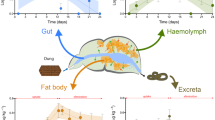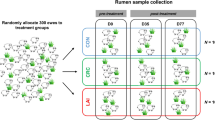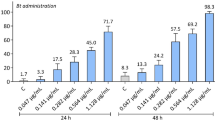Abstract
Ivermectin (22,23-dihydroavermectin B1) is a recently discovered, persistent, broad-spectrum, antiparasitic drug of unpredecented potency1,2 which is now routinely administered to cattle, horses, sheep and pigs in many countries. In cattle, it is an efficient control for parasitic gastrointestinal and respiratory tract nematodes, warble fly, mites, lice and ticks3–6. However, most of the ivermectin dose is ultimately eliminated in the faeces of the treated animals7 where it has been shown to have an insecticidal effect8–11 on the larvae of economically important, dung-breeding, haematophagous Diptera. Nevertheless, the effects of excreted ivermectin on the cowpat fauna as a whole and the wider consequences of such effects have not previously been considered. In field trials reported here, the faeces of calves fitted with rumenal boluses delivering ivermectin at 40 μg per kg per day, failed to degrade in the normal way and this failure was associated with the absence of dung-degrading insects. Faeces from placebo-treated controls contained a characteristic dung-degrading invertebrate community and were largely degraded within 100 days. These results indicate that the increasing widespread use of ivermectin may have important environmental consequences for pastureland.
This is a preview of subscription content, access via your institution
Access options
Subscribe to this journal
Receive 51 print issues and online access
$199.00 per year
only $3.90 per issue
Buy this article
- Purchase on Springer Link
- Instant access to full article PDF
Prices may be subject to local taxes which are calculated during checkout
Similar content being viewed by others
References
Burg, R. W. et al. Antimicrob. Agents Chemother. 15, 361–367 (1979).
Egerton, J. R. et al. Antimicrob. Agents Chemother. 15, 372–378 (1979).
Armour, J., Bairdon, K. & Preston, J. M. Vet. Rec. 107, 226–227 (1980).
Barth, D. & Sutherland, I. H. Zentbl Bakt. ParasilKde I Abt. 267, 319 (1980).
Centurier, C. & Barth, D. Zentbl. Bakt. ParasilKde I Abt. 267, 319 (1980).
Egerton, J. R. et al. Br. vet. J. 136, 88–97 (1980).
Campbell, W. C., Fisher, M. H., Stapley, E. O., Albers-Schonberg, G. & Jacob, T. A. Science 221, 823–828 (1983).
Miller, J. A., Kunz, S. E., Oehler, D. D. & Miller, R. W. J. Econ. Ent. 74, 608–611 (1981).
Schmidt, C. D. Envir. Ent. 12, 455–457 (1983).
Drummond, R. O. S. West. Ent. Suppl. 7, 34–42 (1985).
Schmidt, C. D. & Kunz, S. E. J. Econ. Ent. 73, 702–703 (1980).
Chisholm, M. D. thesis, Bristol Univ. (1980).
Skidmore, P. The Insects Of the Cow Duing Community (Aidgap Ling Ltd, Dorset, 1985).
Marsh, R. & Campling, R. C. Herb. Abstr. 40, 123–130 (1970).
Greehalgh, J. F. D. & Reid, G. W. J. agric. Sci., Camb. 72, 223–228 (1969).
Anderson, J. R., Merritt, R. W. & Loomis, E. C. J. Econ. Ent. 77, 133–141 (1984).
Bornemissza, G. F. Australian Meat Research Committee Review 30, 1–30 (1976).
Anderson, J. R. & Loomis, E. C. Calif, Agric. 32, 31–32 (1978).
Author information
Authors and Affiliations
Rights and permissions
About this article
Cite this article
Wall, R., Strong, L. Environmental consequences of treating cattle with the antiparasitic drug ivermectin. Nature 327, 418–421 (1987). https://doi.org/10.1038/327418a0
Received:
Accepted:
Issue Date:
DOI: https://doi.org/10.1038/327418a0
This article is cited by
-
Environmental impacts of mass drug administration programs: exposures, risks, and mitigation of antimicrobial resistance
Infectious Diseases of Poverty (2022)
-
Effects of Avermectins on the Environment Based on Its Toxicity to Plants and Soil Invertebrates—a Review
Water, Air, & Soil Pollution (2022)
-
Genome-wide associations and functional gene analyses for endoparasite resistance in an endangered population of native German Black Pied cattle
BMC Genomics (2019)
-
Adverse effects of routine bovine health treatments containing triclabendazole and synthetic pyrethroids on the abundance of dipteran larvae in bovine faeces
Scientific Reports (2019)
-
Ivermectin to reduce malaria transmission I. Pharmacokinetic and pharmacodynamic considerations regarding efficacy and safety
Malaria Journal (2017)
Comments
By submitting a comment you agree to abide by our Terms and Community Guidelines. If you find something abusive or that does not comply with our terms or guidelines please flag it as inappropriate.



